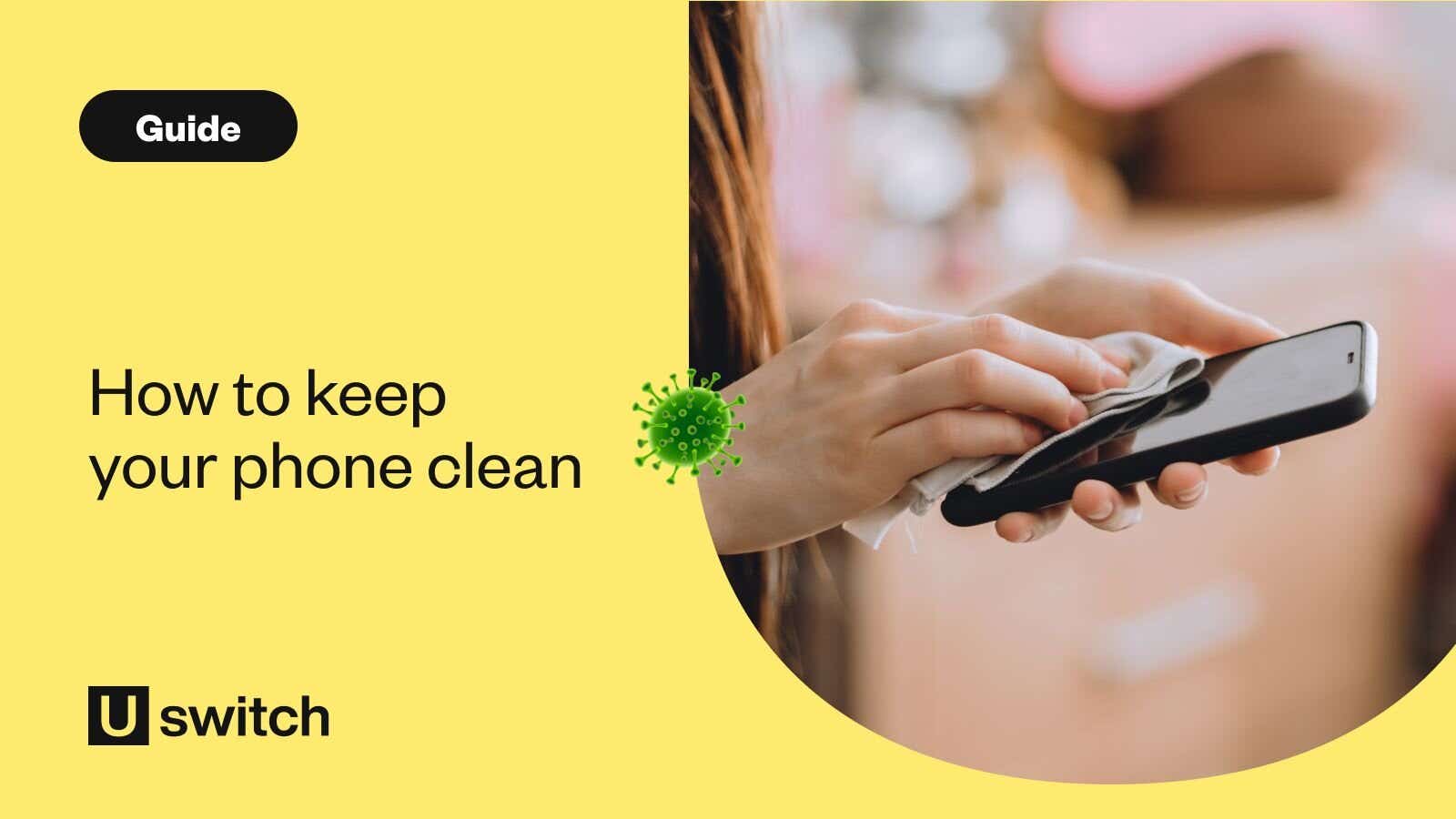How to clean your smartphone: kill germs, bacteria and viruses


Most of us touch our smartphones more than anything else. In fact, research has shown that the average user wakes up their screen nearly 100 times a day. And there are similarly depressing statistics that suggest that most of us look at our phones more than we look at our partners. Romantic, huh?
But with forms of COVID still around, your smartphone addiction has the potential to harm more than your love life. Studies have shown that COVID-19 can survive on surfaces for days, which means that it could be living on your phone.
So, no matter how many rounds of Happy Birthday you sing while washing your hands, you could undo all the good of your antibacterial handwash the second you pick up your handset to message your friends, particularly if you press it against your face to make a call.
Don’t worry, though. Just follow our simple step-by-step guide to cleaning your smartphone, and you’ll be able to kill off any harmful bacteria and virus particles without damaging your device.
We've teamed up with cleaning specialist Jim Gildea at Total Trauma Cleaning. He was actually called to the clean-up for the original COVID-19 patient zero here in the UK. He's given us his tried-and-tested cleaning tips to help you keep your phone clean during the pandemic.
He said, “It's great to see Uswitch taking a leading stance on advising its consumers in best practices of infection prevention and control”.
So read on to find out exactly how to clean your smartphone:
1. Unplug your charger and accessories
First, make sure all the ports on your phone are completely free. Remove the charger, headphones, and anything else you might have plugged in.
Your charger and accessories must be cleaned separately. We’ll walk you through how to do that shortly.
2. Remove your phone case
Again, your phone case will need cleaning separately. So, make sure you take your phone out of its case or protective cover. We’ll discuss how to clean phone covers and cases further down.
3. Get the right cleaning equipment
Most modern-day smartphones have some level of waterproof protection. If you’re interested, any phone with a rating of IP67 or above can be dunked underwater without breaking. But even if your phone can survive being rinsed, it’s not the most effective way to disinfect it.
Instead, we recommend using an alcohol-based wipe or spray to kill off any nasty bugs living on your phone's surface.
According to Apple, disinfectant wipes with up to 70% isopropyl rubbing alcohol are safe to use without harming your iPhone. While other phone manufacturers haven’t given any official guidance on how to clean their products, this is a good rule of thumb, as these wipes should be okay to use on most devices.
However, if you’re finding alcohol-based wipes hard to get hold of at the moment, Jim Gildea recommends using a solution of 50% white vinegar and 50% distilled water. To test this, Jim measured the RLU (relative light units), which indicates how clean a surface is. He tested the RLU on his phone before and after cleaning his smartphone with the water and vinegar solution.
Before cleaning, his phone had a reading of over 200. But it had a reading of just nine after using white vinegar and water. To put that into perspective, that's even cleaner than the recommended levels for operating theatres, food preparation surfaces and labour delivery rooms.
Even if you can't get hold of white vinegar, a simple antibacterial spray and a clean microfibre cloth can still be effective, as long as the bottle says it kills 99.9% of germs and bacteria.
Gildea stressed the importance of using a different microfibre cloth every time you clean your device. To minimise waste, he recommends cutting up a microfibre cloth into smaller pieces. Just be sure to throw the cloth away once you finish with it.
No microfibre cloth? A clean piece of kitchen roll works well too.
To avoid damaging the screen, spray antibacterial cleaner onto a cloth or kitchen roll instead of your phone.
When you’re using the antibacterial spray or water and vinegar in a spray bottle, aim for a light mist rather than dousing the cloth with lots of cleaning fluid. If the cloth is too damp, it could leave streak marks on your screen or even damage your phone if your device isn’t waterproof.
4. Wipe your phone
Rub your disinfectant wipe or antibacterial cloth over your phone, ensuring you clean the device's front, back and sides.
5. Get into the nooks and crannies
Here’s where you might need to be a bit careful. The ports, camera lenses and even the tiny hole that lets you access the SIM tray can trap bits of dirt in them.
To cleanse them without damaging the phone, use a cotton bud or wooden toothpick to clean around the camera lenses, buttons and ports gently. Be careful not to stick it into the ports, though, as that could damage the interior of the phone.
Once that’s done, use your cloth to wipe away any grime.
6. Leave your phone to air dry
Now comes the tricky bit: put your phone down and don't touch it until it’s completely dry. We recommend leaving it for at least 15 minutes.
7. Clean your phone case
While you’re trying to stave off the boredom brought on by not being able to touch your phone, now’s a great time to clean your case.
Now, the best way to do this depends on what your case is made of. Here are the different methods:
How to clean a silicone phone case
The good news about a silicone case is that it can be completely submerged underwater without damage. Just make sure you’ve removed your phone from the case before you do that.
Get a bowl of warm water, add a squirt of washing-up liquid or detergent and dunk your silicone case in. Use a soft cloth to gently clean the whole case. So that’s the outside and the inside, as well as in and around all the holes for the ports and the buttons.
Then let it completely air dry before returning your phone to the case.
How to clean a plastic phone case
This is a very similar process to cleaning your phone. So get your microfibre cloth and antibacterial spray and clean the entire case. And again, use a cotton bud or toothpick to remove any dirt from the buttons, ports and lens opening areas. Then allow it to dry before reinserting your phone.
How to clean your leather phone case
Leather phone cases are a bit trickier to clean. To clean it without damaging the case, you’ll need a saddle soap that’s safe for use on leather. And then to keep it looking its best, treat it with a leather conditioner afterwards. Make sure it’s completely dry before putting the case back onto your phone.
8. Clean your charger and accessories
Use antibacterial spray and cloth to gently clean your charger, headphones, and any other smartphone accessories you use regularly.
Tips to keep your phone clean
We normally advise repeating this phone cleanse at least once a week. But while Coronavirus is at large, it’s probably a sensible idea to do it even more regularly than that.
In the meantime, here are our other top tips to keep your phone free from germs and bacteria:
- Don’t take your phone to the toilet with you.
- I know using it while you’re on the loo is tempting. But as studies have shown that as many as one in six phones actually have faecal matter on them, taking your phone to the toilet with you is a really easy way for it to get covered in bacteria. So leave it at your desk and take a book to read instead. If you’re stuck, we’d recommend 52 Things to Learn on the Loo.
- Wash your hands more regularly.
- I know we’re all bored of hearing this. But the easiest way to keep your phone clean is to make sure your hands are clean when you use it.
- Don’t keep it in the same pocket as your dirty tissues:
- If you sneeze or blow your nose on a tissue and then, while it’s still damp with snot, stick it in the same pocket as your phone, those germs are bound to transfer onto your device. So, throw your used tissue away instead.
- Get a UV light sanitiser.
- If you’re really concerned about germs, it might be worth investing in a small ultraviolet light sanitiser. These clever devices will use light rays to kill bacteria without causing damage to your phone from excessive moisture or heat. And the best thing about this device is that you can use it on more than just your phone: think car keys, chargers or any other small items you handle on a regular basis. You can buy a UV light sanitiser on Amazon.